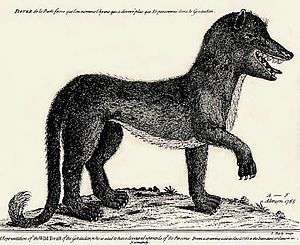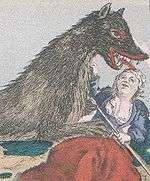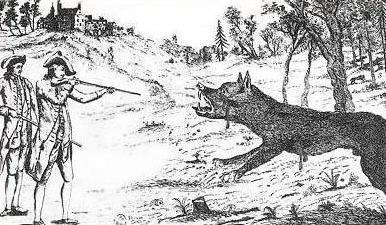Beast of Gévaudan
 Artist's conception of one of the Beasts of Gévaudan, 18th-century engraving by A.F. of Alençon | |
| Grouping | Possibly wolves, wolfdogs or hyenas |
|---|---|
| First reported | 1764 |
| Other name(s) |
La bête du Gévaudan (French) La Bèstia de Gavaudan (Occitan) Wolf of Chazes Lycopardus parthenophagus[1] |
| Country | France |
| Region | Gévaudan (modern-day Lozère) |
The Beast of Gévaudan (French: La Bête du Gévaudan; IPA: [la bɛt dy ʒevodɑ̃], Occitan: La Bèstia de Gavaudan) is the historical name associated with the man-eating gray wolf, dog or wolfdog which terrorized the former province of Gévaudan (modern-day département of Lozère and part of Haute-Loire), in the Margeride Mountains in south-central France between 1764 and 1767.[2] The attacks, which covered an area stretching 90 by 80 kilometres (56 by 50 mi), were said to have been committed by a beast or beasts that had formidable teeth and immense tails according to contemporary eyewitnesses.
Victims were often killed by having their throats torn out. The Kingdom of France used a considerable amount of manpower and money to hunt the animals; including the resources of several nobles, soldiers, civilians, and a number of royal huntsmen.[2]
The number of victims differs according to sources. In 1987, one study estimated there had been 210 attacks; resulting in 113 deaths and 49 injuries; 98 of the victims killed were partly eaten.[2] However, other sources claim it killed between 60 and 100 adults and children, as well as injuring more than 30.[2]
Description
Descriptions of the time vary, but generally the beast was said to look like a wolf but be about as big as a calf. It had a large dog-like head with small straight ears, a wide chest, and a large mouth which exposed very large teeth. The beast's fur was said to be red in color but its back was streaked with black.[3]
History

Beginnings
The Beast of Gévaudan carried out its first recorded attack in the early summer of 1764. A young woman, who was tending cattle in the Mercoire forest near Langogne in the eastern part of Gévaudan, saw the beast come at her. However, the bulls in the herd charged the beast, keeping it at bay. They then drove it off after it attacked a second time. Shortly afterwards the first official victim of the beast was recorded; 14-year-old Janne Boulet was killed near the village of Les Hubacs near the town of Langogne.
Over the later months of 1764, more attacks were reported throughout the region. Very soon terror had gripped the populace because the beast was repeatedly preying on lone men, women and children as they tended livestock in the forests around Gévaudan. Reports note that the beast seemed to only target the victim's head or neck regions.
By late December 1764 rumors had begun circulating that there might be a pair of beasts behind the killings. This was because there had been such a high number of attacks in such a short space of time, many had appeared to have been recorded and reported at the same time. Some contemporary accounts suggest the creature had been seen with another such animal, while others thought the beast was with its young.
On January 12, 1765, Jacques Portefaix and seven friends were attacked by the Beast. After several attacks, they drove it away by staying grouped together. The encounter eventually came to the attention of Louis XV, who awarded 300 livres to Portefaix and another 350 livres to be shared among his companions. The king also directed that Portefaix be educated at the state's expense. He then decreed that the French state would help find and kill the beast.
Royal intervention

Three weeks later Louis XV sent two professional wolf-hunters, Jean Charles Marc Antoine Vaumesle d'Enneval and his son Jean-François, to Gévaudan. They arrived in Clermont-Ferrand on February 17, 1765, bringing with them eight bloodhounds which had been trained in wolf-hunting. Over the next four months the pair hunted for Eurasian wolves believing them to be the beast. However, as the attacks continued, they were replaced in June 1765 by François Antoine (also wrongly named Antoine de Beauterne), the king's arquebus bearer and Lieutenant of the Hunt who arrived in Le Malzieu on June 22.
On September 20, 1765, Antoine had killed his third large grey wolf measuring 80 cm (31 in) high, 1.7 m (5 ft 7 in) long, and weighing 60 kilograms (130 lb). The wolf, which was named Le Loup de Chazes after the nearby Abbaye des Chazes, was said to have been quite large for a wolf. Antoine officially stated: "We declare by the present report signed from our hand, we never saw a big wolf that could be compared to this one. Which is why we estimate this could be the fearsome beast that caused so much damage." The animal was further identified as the culprit by attack survivors who recognised the scars on its body inflicted by victims defending themselves.[2] The wolf was stuffed and sent to Versailles where Antoine was received as a hero, receiving a large sum of money as well as titles and awards.
However, on December 2, 1765, another beast severely injured two men. A dozen more deaths are reported to have followed attacks by La Besseyre-Saint-Mary.
Final attacks
The killing of the creature that eventually marked the end of the attacks is credited to a local hunter named Jean Chastel, who shot it during a hunt organized by a local nobleman, the Marquis d'Apcher, on June 19, 1767. Writers later introduced the idea that Chastel shot the creature with a blessed silver bullet of his own manufacture and upon being opened, the animal's stomach was shown to contain human remains.[4]
Theories

According to modern scholars, public hysteria at the time of the attacks contributed to widespread myths that supernatural beasts roamed Gévaudan, but deaths attributed to a beast were more likely the work of a number of wolves or packs of wolves.[5][6] In 2001 the French naturalist Michel Louis proposed that the red-colored mastiff belonging to Jean Chastel sired the beast and its resistance to bullets may have been due to it wearing the armoured hide of a young boar thus also accounting for the unusual colour.[7] The problem of attacks by wolves in those years was very serious, not only in France but throughout Europe, with tens of thousands of deaths in the eighteenth century alone.[8]
Depictions in fiction
Literature
- the first literary reference to the 'Beast Of Gévaudan' occurs in Élie Berthet's 1858 novel La Bête du Gévaudan [translated as "The Beast of Gevaudan" but not currently available in English], in which the killings are attributed to both a wolf and a man who believes himself to be a werewolf.
- in 1904, the author and journalist Robert Sherard faithfully revisited Berthet's idea with his novel Wolves: An Old Story Retold which once again featured both a werewolf and a huge savage wolf. Élie Berthet's La Bête du Gévaudan is referenced in the introduction as being the source of the story.
- Robert Louis Stevenson travelled through the region in 1878 and described the incident in his book Travels with a Donkey in the Cévennes, in which he claims that at least one of the creatures was a wolf:
For this was the land of the ever-memorable Beast, the Napoleon Bonaparte of wolves. What a career was his! He lived ten months at free quarters in Gévaudan and Vivarais; he ate women and children and "shepherdesses celebrated for their beauty"; he pursued armed horsemen; he has been seen at broad noonday chasing a post-chaise and outrider along the king's high-road, and chaise and outrider fleeing before him at the gallop. He was placarded like a political offender, and ten thousand francs were offered for his head. And yet, when he was shot and sent to Versailles, behold! a common wolf, and even small for that.
- In the Patricia Briggs novel Hunting Ground, the Beast is in fact Jean Chastel, who is a werewolf.
Film and television
- The beast featured in an episode of Animal X suggesting it was a wolf-dog hybrid that was trained to attack people.
- The French television film La bête du Gévaudan (2003),[9] directed by Patrick Volson was based on the attacks of the Beast
- Brotherhood of the Wolf (2001),[10] directed by Christophe Gans, is a popular feature film based on the legend. The film took several creative liberties in order to make the story more interesting to a general audience. Rather than a wolf or wolf-dog crossbreed, the movie portrays the creature as the offspring of a lion crossbred with another unknown big cat, equipped with armor to make it seem more threatening. The Beast is the instrument of the film's eponymous secret organisation, which attempts to undermine public confidence in the king and ultimately take over the country by stating that the Beast is a divine punishment for the King's indulgence of the modern embrace of science over religion.
- In the 2010 remake The Wolfman the wolf-headed cane given to Lawrence Talbot was acquired, according to the previous owner, in the city of Gévaudan.
- In October 2009, the History Channel aired a documentary called The Real Wolfman which argued that the beast was an exotic animal in the form of a striped hyena, a long-haired species of hyena now extinct in Europe.[11]
- In the MTV drama Teen Wolf, the character Allison learns in the sixth episode of the first season that her werewolf-hunting family was responsible for slaughtering the Beast of Gévaudan. The same beast is the main focus of the second half of the series' fifth season.[12]
See also
References
- ↑ Woodward, Ian (1979). The Werewolf Delusion. p. 256. ISBN 0-448-23170-0.
- 1 2 3 4 5 "The Fear of Wolves: A Review of Wolf Attacks on Humans" (PDF). Norsk Institutt for Naturforskning. Archived from the original (PDF) on 2008-12-09. Retrieved 2008-06-26.
- ↑ Pourcher, Pierre (1889) Translated by Brockis, Derek The Beast of Gevaudan AuthorHokuse, 2006, p.5 ISBN 9781467014632
- ↑ Jackson, Robert (1995). Witchcraft and the Occult. Devizes, Quintet Publishing. p. 25. ISBN 1-85348-888-7.
- ↑ Smith, Jay M. (2011). Monsters of the Gévaudan. Cambridge, Massachusetts: Harvard University Press. p. 6. ISBN 0-674-04716-8.
- ↑ Thompson, Richard H. (1991). Wolf-Hunting in France in the Reign of Louis XV: The Beast of the Gévaudan. p. 367. ISBN 0-88946-746-3.
- ↑ Louis, Michel (2001). La Bête Du Gévaudan – L'innocence Des Loups. Librairie Académique Perrin. ISBN 978-2-262-01739-2.
- ↑ The man-eater of Gévaudan: when the serial killer is an animal, by Giovanni Todaro, 2014, Lulu Com, 539 pages, ISBN 9781291503401
- ↑ Patrick Volson (Director) (2003). La Bête du Gévaudan (Motion picture).
- ↑ Christophe Gans (Director) (2001). Le Pacte des Loups (Motion picture).
- ↑ "The Real Wolfman". History Alive. Season 4. Episode 16. History. Retrieved 2009-10-29.
- ↑ Massabrook, Nicole (February 24, 2016). "'Teen Wolf' Season 5B Spoilers: Episode 19 Synopsis Released; What Will Happen In 'The Beast Of Beacon Hills'?". International Business Times. Retrieved March 9, 2016.
External links
| Wikimedia Commons has media related to Beast of Gévaudan. |
- A comprehensive history on the Beast of Gévaudan
- Robert Darnton, The Wolf Man's Revenge, The New York Review of Books, June 9, 2011; review of Monsters of the Gévaudan: The Making of a Beast by Jay M. Smith (Harvard University Press, 2011).
- Multi language site of the Beast of Gévaudan.
- Solving the Mystery of the 18th-Century Killer “Beast of Gévaudan” (National Geographic)